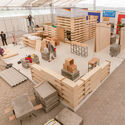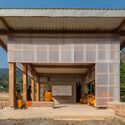 Technology and Environment Laboratory Mencoriari / Semillas © Eleazar Cuadros
Technology and Environment Laboratory Mencoriari / Semillas © Eleazar Cuadros
Share
Or
https://www.archdaily.com/1032525/rural-lab-latin-americas-countryside-as-a-space-for-experimentation
What if the future of architecture lies not in the cities, but beyond them? For decades, urbanization has dominated both discourse and statistics. We are constantly bombarded with data confirming the prevalence of urban life, but we rarely ask the opposite question: what did those who moved to the cities leave behind? What remains alive and evolving far from urban centers?
The countryside—long underestimated—is now emerging as fertile ground for possibility. More than a “marginalized space,” rural Latin America today asserts itself as a true laboratory for architectural, social, and ecological experimentation. From agroecological communities to low-impact technologies, from relationships between humans, machines, and other living beings to locally grounded solutions for global challenges—such as the climate crisis, food security, and migration—the rural world is actively and inventively reshaping its own future.
Although home to half the world’s population, rural areas have been sidelined by dominant urban narratives, often reduced to “terra incognita”—much like 18th-century maps where vast regions of the globe appeared as empty, mysterious, unexplored spaces. For decades, little was said about what happens outside the cities. But today, while urban centers consolidate their infrastructure, the countryside is undergoing profound and surprising transformations. Far from being static or outdated, the contemporary rural landscape has become a dynamic arena of change: biotechnology, seasonal migration, government subsidies, flexible agriculture, and digital monitoring all coexist in this territory in flux. It is hard to imagine an urban setting as radically diverse as this.
Related Article From Extraction to Regeneration: Architecture’s Role in Rural Developments in Latin America  Escola Rural Básica Cantino / Taller Viga Maestra. © Rodrigo Pastor Pensa
Escola Rural Básica Cantino / Taller Viga Maestra. © Rodrigo Pastor Pensa
Livestock farming, for instance, is now almost entirely automated: feeding, cleaning, and herd management are carried out by robots. The farmer—now more of a data analyst than a field worker—operates everything from a computer-equipped room, processing digital information that results in millions of liters of milk each year. The tractor, once a symbol of the 19th-century agricultural revolution, has become a sophisticated digital workstation. Equipped with sensors and algorithms, it connects the operator directly to the soil, maximizing land productivity. Rural labor has become a digital practice, and the countryside—vast and multifaceted—is now also a virtual landscape.
This wave of innovation has also reached the field of architecture, giving rise to strategies deeply rooted in local ecologies and territorial knowledge. More than simply adopting new technologies, what we see is a paradigm shift: the materials and techniques employed reflect a worldview that recognizes the interdependence of culture, environment, and ways of life.
 Escola Rural Básica Cantino / Taller Viga Maestra. © Rodrigo Pastor Pensa
Escola Rural Básica Cantino / Taller Viga Maestra. © Rodrigo Pastor Pensa
One notable example is the Cantino Rural School in Chile, designed by Taller Viga Maestra, where wood is used as the primary material, combining simplicity, rural identity, and integration with the landscape. However, the structure was digitally modeled using Cadwork software and fabricated via CNC technology by the company Timber—demonstrating how digital manufacturing can be applied to rural vernacular architecture to produce precise, efficient, and context-sensitive solutions. Similarly, by combining technology with traditional knowledge, the Post-Earthquake Prototype – Rural Dwelling in Ecuador by AL BORDE + El Sindicato Arquitectura presents a housing model designed specifically for rural areas. Built with laminated wood and designed to be assembled without heavy machinery or specialized labor, it merges technical efficiency with local elements like earth-based paints and cane walls.
 Escola Rural Básica Cantino / Taller Viga Maestra. Construction Process 01
Escola Rural Básica Cantino / Taller Viga Maestra. Construction Process 01 Post-Earthquake Prototype – Rural Dwelling / AL BORDE + El Sindicato Arquitectura © JAG Studio
Post-Earthquake Prototype – Rural Dwelling / AL BORDE + El Sindicato Arquitectura © JAG Studio
The transformative power of innovation also reveals itself through the direct participation of communities in the architectural process. Initiatives like the Babaçu Flour House by Estudio Flume in Maranhão, Brazil, show how built environments can support solidarity-based economies and women’s leadership. In this case, the innovation lies not in the construction technique, but in the collaborative and circular logic that underpins the project—a logic that challenges traditional production models and positions architecture as a tool for social empowerment. It is a kind of innovation that is communal, educational, and political.
 Casa de Farinha de babaçu Refurbishment / Estudio Flume . Courtesy of Noelia Monteiro
Casa de Farinha de babaçu Refurbishment / Estudio Flume . Courtesy of Noelia Monteiro
Lastly, it is worth highlighting rural technology centers that embody this place-based and innovative approach. The Mencoriari Technology and Environment Laboratory, located in Peru, was developed by Semillas through a participatory process, bringing together natural building, agroecology, and technical training in a learning environment attuned to the rhythms of the forest. Here, technology is not a rupture with nature, but a careful mediation between innovation and tradition. This model shows that when rooted in social and ecological contexts, innovation is less about disruption and more about continuity: continuity of bonds with the land, with community, and with life forms that resist the homogenizing logic of urban expansion.
 Technology and Environment Laboratory Mencoriari / Semillas © Eleazar Cuadros
Technology and Environment Laboratory Mencoriari / Semillas © Eleazar Cuadros
These examples make it clear that Latin America’s rural regions are emerging as powerful spaces for experimentation and innovation. In the face of challenges such as water scarcity, food insecurity, and infrastructural precarity, creative responses are taking shape, anchored in local knowledge and supported by collaborative practices. This is not a futuristic vision, but a “futurable” one—possible because it is rooted in reality and alliances between humans and nature. In this context, the countryside is no longer seen as a symbol of backwardness, but as a space of reinvention, showing that ignoring its potential in favor of urban obsession is not just outdated, but irresponsible. After all, we cannot understand the city without understanding the countryside.
This article is part of the ArchDaily Topics: Regenerative Design & Rural Ecologies. Every month we explore a topic in-depth through articles, interviews, news, and architecture projects. We invite you to learn more about our ArchDaily Topics. And, as always, at ArchDaily we welcome the contributions of our readers; if you want to submit an article or project, contact us.





